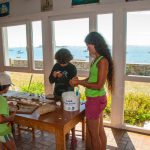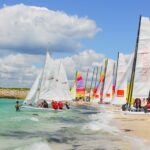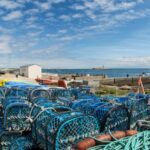Geographical highlights of the Glénan archipelago
This string of islands is located in the Finistère region, some 10 nautical miles (18 Km) to the south of Fouesnant, to which it is administratively attached. Etymologically speaking, the name Glénan is evocative of a valley, a circle of sea or a room. The islands indeed form a circle with a sort of lagoon at the centre locally called « la Chambre » (the room), which is bordered by the Saint-Nicolas, Drenec, Bananec and Cigogne Islands. The absolutely clear waters are a feast for leisure crafts, which flock there in summer. The Glénan archipelago in fact partly owes its clear waters to the presence of beds of the Maërl, a calcareous marine algae whose splitting up contributes to the whiteness of the sand.
Crossing times vary between 2 and 3 hours for an average sailboat, while it takes only 15 to 30 minutes with a motorboat from the nearest coast point.
Temperate oceanic climate
Due to the influence of the Gulf Stream, the archipelago enjoys a micro climate and has less rain than the mainland and lower temperature ranges.
t receives less rainfall than the mainland, with lower thermal amplitude. The average water temperature in winter is around 7 to 10°C, while the average temperature in summer ranges between 14 and 18°C in August. The presence of a thermocline layer is noted at 15 to 18 m deep in summer.
Few areas of the archipelago apart from « la Chambre » and the east are sheltered from the dominant winds blowing from the west.
Environmental policies of local authorities
The absence of electric poles, cars and asphalted roads naturally places the archipelago in the spirit of sustainable development. The municipality of Fouesnant, to which the archipelago is administratively attached, had to look for solutions to preserve its natural heritage and to address the needs of the tourism sector. Between 1995 and 2000, it supported the Life – « Managing the environment for a sustainable tourism development » project. This initiative has enabled the implementation of complementary solutions related to water, energy and waste management using innovative techniques. The equipment installed has contributed to sensitise people using the archipelago to its environmental specificities and bring about a change in the behaviour of visitors. The success of the Life project has been successful in enabling a noticeable improvement of the environment of the archipelago by ensuring a sustainable tourist activity and serves today as a reference for other islands around Europe.
Water resources
Water tanks and wells exist on the main islands but there is no drinking water, which must be shipped by barges from the mainland.
Electricity
The island is equipped with a thermal electricity plant using three energy sources : wind, solar and thermal energy. Since 1985, the French electricity company, EDF uses the archipelago to showcase its windmill and solar panel farm. Adapted to the insular environment, the park supplies the hospitality infrastructures (restaurants, sailing school and international diving centre) on Saint Nicolas, Bananec, Drenec, Penfret and Cigogne Islands with electricity. The uniqueness of the system resides in the regulation of the entire infrastructure with wind and photovoltaic energy representing almost all of the production. The energy production installations at Penfret comprising 120 photovoltaic panels are connected to a 120-volt circuit and a windmill with 7-metre diameter blades, producing each around 20,000 Wh daily depending on wind and sunshine conditions. The mechanism is completed with 60 batteries for a total of 120 volts, enabling the storage of 1,870,000 Wh. The average daily energy consumption in summer amounts to 15,300 Wh and even when production is low due to lack of wind or sun, the installation ensures five days of energy autonomy. The entire plant has been restored by the town council of Fouesnant through the Life – « Managing the environment for a sustainable tourism development » project. It provides for the energy needs of a dozen houses, which represents the requirements of the two restaurants on the island and of the houses of the permanent staff of the nautical centre of Glénan. However, the park is becoming obsolete and the eolian energy system is not at its optimum given that the energy needs rise in summer, which is the least windy period of the year.
Macro-waste
All the garbage is taken away by barges in summer. To limit the volume of waste shipped to the mainland, the municipality has held this summer a sensitisation campaign inviting visitors to take their waste back with them. To this effect, bins have been removed from Saint-Nicolas Island. According to Nathalie Delliou, warden of the natural park, tourists have contributed to the initiative and the loads of barges have been reduced.
A preserved natural site
The land and sea habitats of the Glénan archipelago both feature a rich ecosystem with a very fine balance of islands, lochs, islets, reefs on the outer edge, associated hydrodynamics, diversity of exposure, vegetation and distance from the mainland. The bird fauna of the Glénan archipelago comprises a total of 33 nesting species as well as 105 other migrating or winter feeding birds.
The archipelago is now protected by different legal measures. The entire archipelago is a listed Natural Site by decree since 18 October 1973. Any works likely to alter the state or the natural aspect of the place as well as camping and advertising are prohibited.
Maërl extraction is banned
Two shipping businesses, the « Sabliers de l’Odet » and the « Compagnie Armoricaine de Navigation » presently exploit the Maërl deposits of the Glénan archipelago. Maërl extraction and transformation account today for 200 jobs and a FRF200m (€3m) turnover. The state has granted one last concession for sand extraction and operators are allowed to extract 45,000 tons of Maërl yearly in a 50-acre zone until 2011, when the activity will be definitively banned.
The natural reserve
The long term management of the Saint-Nicolas area is ensured by Bretagne Vivante Association through the setting up of a natural reserve created in 1974 to protect the Glénan Daffodil (Narcissus triandrus). It is a true botanical curiosity that only grows in some places of the archipelago towards the end of March-beginning of April. Discovered by a pharmacist from Quimper in 1803, the Glénan Daffodil keeps attracting botanists and onlookers who travel long distances at flowering time. The Glénan Daffodil measures between 15 and 40 cm high with narrow leaves and whitish odourless flowers. It is considered as the rarest plant of the Armorican Massif and one of most uncommon in Europe. A protected area has been created around the natural reserve in 1997 covering all the unbuilt areas on Saint-Nicolas and on the Brunec, Le Veau and La Tombe islets. The natural reserve’s land is owned by the General Council of Finistère and is managed by the SEPNB (Society for the Study and Protection of Nature), an association for the protection of the environment.
Natura 2000 area
Besides its classification, the reserve forms part of the Natura 2000 area, which is a network of natural protected sites in Europe. The Glénan archipelago, which plays an important role in the reproduction of terns, of the snowy plover (Charadrius alexandrinus) and of the Eurasian oystercatcher (Haematopus ostralegus), is concerned by two directives of the European Union. The first one relates to Special Conservation Areas which aim at protecting and managing rare and vulnerable natural habitats, plant and animal species. The other one pertains to Special Protection Areas. The entire archipelago including « Île aux Moutons », representing a surface area of about 5,300 ha with 98% of sea, is concerned by these two directives.
Outstanding nautical events of the archipelago
The nautical rally of the Glénan archipelago
This event is a must for all people who love sailing and the archipelago. The rally take place from Concarneau with hundreds of participants alternating between windward/leeward and coastal races. Participants can register on their own or as a crew and can navigate aboard boats from Glénan measuring 9 to 11 metres (Sun Fast 37, Glenans 33, Fast 32i and Ian 31) under the supervision of qualified skippers from the archipelago. Participants can also use their own boats.
Cata Fun
The first edition of the Cata Fun event was held by the Nautical Centre of Glénan in August 2009 in the Glenan archipelago. The regatta is open to all without level restrictions. The aim is not to compete but to enjoy the pleasures of sailing and gliding in a team spirit and a friendly atmosphere.
Maritime environment
Attracted by clear waters, heavenly moorings, microclimate of the landscapes, many boaters are coming to the archipelago during the summer season.
The clear waters and the microclimate of the archipelago attract a number of leisure crafts and other types of boats to the moorings of the archipelago. There are sometimes up to 100 boats in summer. The average crossing time for a sailing boat varies between 2 and 3 hours whereas motorboats take only 15 to 30 minutes.
The favourite mooring spots are located on the stretch of water La Pie and the Room, a lagoon where moorings facilities for 150 boats have been installed to protect the sea meadows, which are decreasing in number. Boat anchors tend to pull large chunks of eel grass along with their rhizomes and roots and boats’ chains damage the leaves within their swinging room. It should be noted that the damaged sea meadows take years to recover.
Other open sea moorings are scattered around the archipelago: the Loc’h (grounding) and Penfret coves are highly frequented in summer but the surroundings of the Drenec and Cigogne Islands, the Vieux Glénan and Guiriden are also pleasant mooring spots when the weather permits.
Landing is banned on certain islets during the nesting period and visitors should refrain from doing so at such periods.
The Glénan archipelago is an area where boat traffic is high and the number should increase in coming years. The town council is presently reviewing the capacity of the archipelago, with over 700 boats waiting for a spot in the Port la Foret harbour ! The yachting harbours have limited capacity and a number of yachtsmen choose to purchase small semi-rigid boats. Such pleasure crafts are accessible to all and are increasing in number in the archipelago. To address the growth in traffic, the town council of Fouesnant is considering a restructuring of the mooring areas to ensure maximum protection for the sea meadows.
Exploitation of the marine resources
Pots, nets, longlines, fishing lines and dragnets are used by local fishermen to catch lobsters, crabs, mullets, wrasses, basses and clams. Only a small number of leisure fishing static gear (trammel nets, pots) are used in the archipelago due to its distance from the mainland. However, fishing lines and longlines (dorados) are very popular.
The regulation establishes minimum catch sizes and no-catch zones for seashore fishing and underwater fishing. It is also recommended to put any moved block back in place to enable the ecosystem to recover.
During spring tides, the Room can be crossed on foot and becomes a haven for seashore fishermen who collect ear shells and clams under the supervision of the marine gendarmerie, which frequently patrols the area.
Boat fishing trips are conducted essentially on the outskirts of the archipelago.
Underwater fishing is banned on the major part of the archipelago following a prefectoral order dated 30 May 1997. Underwater fishing of ear shells and sea urchins is strictly forbidden and spider crab fishing is limited to 6 specimens per person daily. Professional fishermen are allowed to undertake underwater fishing of scallops at specific dates and times and catches are limited to 15 specimens per fisherman daily.
Underwater fishing is a very popular activity beyond the restricted area, that is off the northern and western parts of the archipelago, around Ile aux Moutons and to the east of Penfret.
Cultural highlights of the destination
Once the property of the monks of the abbey of Saint-Gildas de Rhuys, the Glénan archipelago has successively been a base for corsairs, a military base, an industrial site producing soda ash, a sardine and pollack drying site, a lobster-fishing area and a terrain for scientific research. The place has attracted all sorts of population and reached the highest number of inhabitants in its history in the second half of the 18th century. At the time, up to a hundred men were building a fort on Cigogne Island. In 1891, the archipelago counted 85 permanent inhabitants including 15 fishermen and 6 farmers. Some 70 people were still living in the archipelago in 1976, among whom the lighthouse keeper and his family, fishermen and farmers growing wheat, potatoes, cabbages and rearing livestock. Presently, only 4 people, including two professional fishermen, live there all year round. Some houses have been built on Saint Nicolas Island but new construction projects are now prohibited.







